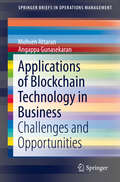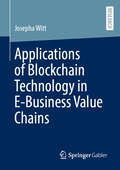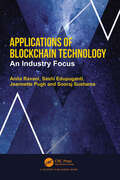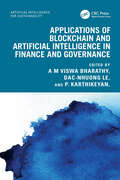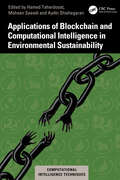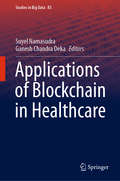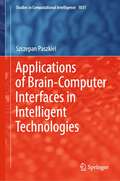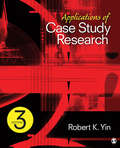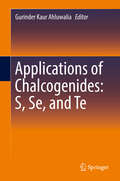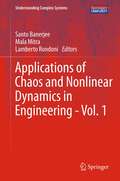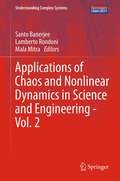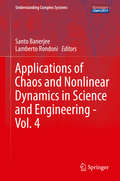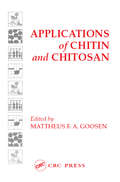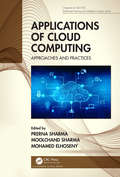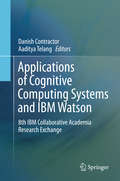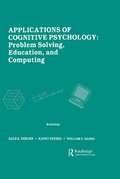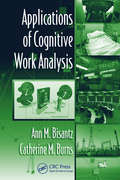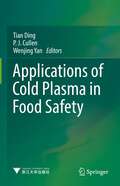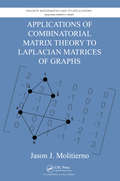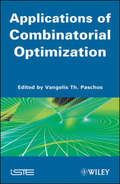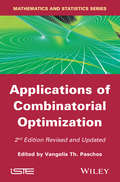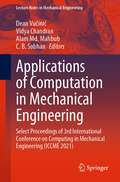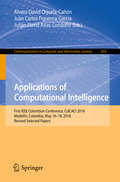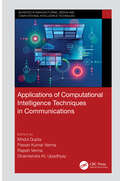- Table View
- List View
Applications of Blockchain Technology in Business: Challenges and Opportunities (SpringerBriefs in Operations Management)
by Angappa Gunasekaran Mohsen AttaranThe book discusses the various ways that blockchain technology is changing the future of money, transactions, government, and business. The first two chapters walk through the foundation of blockchain. Chapters 3–12 look at applications of blockchain in different industries and highlight its exciting new business applications. It show why so many companies are implementing blockchain, and present examples of companies who have successfully employed the technology to improve efficiencies and reduce costs. Chapter 13 highlights blockchain’s powerful potential to foster emerging markets and economies including smart cities, value-based healthcare, decentralized sharing economy, machine to machine transactions, data-sharing marketplace, etc. Chapter 14 offers a conceptual model, provides information and insights, and covers a step-by-step approach to plan and develop blockchain-based technology.
Applications of Blockchain Technology in E-Business Value Chains
by Josepha WittBlockchain Technology (BCT) is explored as a substantial part of the next generation of the Internet affecting business models in e-business. This book explores the application of BCT in e-business focusing on the value creation. The research objective is to examine how and why BCT is used in e-business value chains. This objective is reached through a pragmatic multimethod approach combining four studies. Study 1 summarises the state-of-the-art of approaches to assess a BCT fit for a particular scenario and outlines shortcomings resulting from these approaches. Study 2 provides empirical insights into the usage of BCT in four e-business value chains based on the cases Theta (content), OpenBazaar (commerce), Presearch (context), and Crypviser (connection). Study 3 deepens the insights in the e-commerce value chain. By means of a qualitative content analysis of news articles, various BCT application domains for each e-commerce activity are presented. Study 4 narrows the perspective of analysis to e-negotiations, proposes a BC-based negotiation support system and examines its opportunities and challenges. Finally, an integrative discussion of the findings results in two explanations how BCT is applied in e-business.
Applications of Blockchain Technology: An Industry Focus
by Anita Ravani Sashi Edupuganti Jeannette Pugh Sooraj SushamaBlockchain technology is a disruptive technology that affords businesspeople an opportunity to correct problems of dishonesty, corruption, and poor decision-making. This book crafts blockchain technology for the non-technical expert, to interpret the various applications of blockchain technology through the lens of various industries and creates opportunities for professionals using practical applications and case studies. Blockchain technology is an important platform for businesses to consider as it provides a consensus based, trusted, and transparent system for businesses to operate various critical functions. As such, this book is a first of its kind to take a deep dive into the application of blockchain technology in different sectors. Applications of blockchain technology is explored through understanding of implementation and configuring the use of blockchain technology in real business application. The book provides access to disseminate blockchain technology and its application in a clear and structured manner by assimilating real-world-cases by providing valuable information for business audiences for all business sectors.
Applications of Blockchain and Artificial Intelligence in Finance and Governance (Artificial Intelligence for Sustainability)
by Dac-Nhuong Le P. Karthikeyan A M Viswa BharathyIn the rapidly evolving landscape of finance and governance, the integration of blockchain technology and artificial intelligence is reshaping the way we perceive and interact with traditional systems. In Applications of Blockchain and Artificial Intelligence in Finance and Governance, the authors delve into the intricacies of this dynamic intersection, offering a comprehensive exploration of the transformative potential of these cutting-edge technologies. From dissecting the symbiotic relationship between artificial intelligence and blockchain to examining their profound impact on cryptocurrency markets, each chapter offers invaluable insights into the role of these technologies in shaping the future of finance. With a meticulous review of open risks and challenges, the book navigates through the complexities of data security in public and consortium blockchain systems, paving the way for enhanced trust and transparency in financial transactions. Through real-world case studies and theoretical frameworks, readers are guided through the application of intelligent resource allocation for data analytics, unlocking the potential for optimized decision-making in blockchain-enabled financial transactions. Moreover, the book explores the revolutionary implications of blockchain and AI in maintaining smart governance records, revolutionizing accountability and efficiency in public administration.This book: Introduces a step-by-step procedure for developing blockchain and artificial intelligence-based applications for the finance industry using decentralized applications and hyperledgers. Discusses improved trust framework and data integrity in the blockchain using artificial intelligence in the finance sector. Highlights the importance of blockchain in solving transaction costs, coordination costs, and supervision costs for efficient resource allocation. Explores the use of explainable artificial intelligence for policy development, service delivery, and regulatory compliance. Explains how federated learning can be used to build more accurate and robust models for financial risk assessment, fraud detection, and customer profiling. From the transformative effects on the accounting profession to the burgeoning adoption of blockchain technology in supply chain finance, this book serves as an indispensable guide for professionals, academics, and enthusiasts alike. Applications of Blockchain and Artificial Intelligence in Finance and Governance illuminates the path toward a more secure, efficient, and equitable financial future, where innovation and collaboration reign supreme.
Applications of Blockchain and Computational Intelligence in Environmental Sustainability (Computational Intelligence Techniques)
by Hamed Taherdoost Mohsen Saeedi Aydin ShishegaranThe book explores the complex correlation between blockchain technology and sustainability, demonstrating the potential of cutting-edge computational intelligence methods to address critical environmental and societal challenges. It provides a comprehensive analysis of the most recent developments in research, innovative approaches to design, and real-world implementations, establishing a strategic plan for the incorporation of blockchain technology into environmentally friendly solutions. Features: Focuses on the intersection of blockchain technology, computational intelligence, and sustainability. Covers international regulatory landscapes and ethical considerations. Emphasizes real-world applications such as supply chain management systems and smart energy networks. Offers concrete examples of how these technologies contribute to sustainability. Provides insight into how new technologies are transforming health informatics. This book is aimed at graduate students and researchers in computer engineering and environmental sustainability.
Applications of Blockchain in Healthcare (Studies in Big Data #83)
by Ganesh Chandra Deka Suyel NamasudraThis book discusses applications of blockchain in healthcare sector. The security of confidential and sensitive data is of utmost importance in healthcare industry. The introduction of blockchain methods in an effective manner will bring secure transactions in a peer-to-peer network. The book also covers gaps of the current available books/literature available for use cases of Distributed Ledger Technology (DLT) in healthcare. The information and applications discussed in the book are immensely helpful for researchers, database professionals, and practitioners. The book also discusses protocols, standards, and government regulations which are very useful for policymakers.
Applications of Brain-Computer Interfaces in Intelligent Technologies (Studies in Computational Intelligence #1031)
by Szczepan PaszkielThe BCI technology finds newer and newer implementations. Year by year, the number of publications in this field grows exponentially. This book attempts to describe the implementation of the brain-computer technology based on both STM32 and Arduino microcontrollers. In addition, the application of BCI technology in the field of intelligent houses, robotic lines as well as in the field of bionic prostheses was presented. One of the chapters of the monograph also discusses the issue of fMRI in the context of the possibility of analyzing images made as part of fMRI through solutions based on machine learning. A practical implementation of the TensorFlow framework was presented. The fMRI technique is also often implemented in BCI solutions. The conducted literature studies show that the technology of BCI is undoubtedly a technology of the future. However, there is a need for continuous development of biomedical signal processing methods in order to obtain the most efficient implementations in the case of non-invasive implementation of BCI technology based on EEG. The further development of BCI technology has a huge impact on the techniques of rehabilitation of people with disabilities. Nowadays, wheelchairs are being constructed, thanks to which a disabled person is physically able to direct his position in a certain direction and at a certain speed. Thanks to BCI, it is also possible to create an individual speech synthesizer, with the help of which a paralyzed person will be able to communicate with the outside world. New limb prostheses that will replace the lost locomotor system in almost one hundred percent are still being developed. Some prostheses are connected to the human nervous system, thanks to which they are able to send feedback to our brain about the shape, hardness and temperature of the object held in the artificial limb.
Applications of Case Study Research
by Dr Robert K. YinDesigned to help both graduate students and start-up researchers with their own case study research, this book presents 21 individual applications of the case study method together with cross-referenced discussions of key methodological issues. Many of the applications—including a wide array of single-case studies useful as examples for solo researchers—have been shortened or re-written expressly for this book.
Applications of Chalcogenides: S, Se, and Te
by Gurinder Kaur AhluwaliaThis book introduces readers to a wide range of applications for elements in Group 16 of the periodic table, such as, optical fibers for communication and sensing, X-ray imaging, electrochemical sensors, data storage devices, biomedical applications, photovoltaics and IR detectors, the rationale for these uses, the future scope of their applications, and expected improvements to existing technologies. Following an introductory section, the book is broadly divided into three parts--dealing with Sulfur, Selenium, and Tellurium. The sections cover the basic structure of the elements and their compounds in bulk and nanostructured forms; properties that make these useful for various applications, followed by applications and commercial products. As the global technology revolution necessitates the search for new materials and more efficient devices in the electronics and semiconductor industry, Applications of Chalcogenides: S, Se, and Te is an ideal book for a wide range of readers in industry, government and academic research facilities looking beyond silicon for materials used in the electronic and optoelectronic industry as well as biomedical applications.
Applications of Chaos and Nonlinear Dynamics in Engineering - Vol. 1 (Understanding Complex Systems)
by Lamberto Rondoni Santo Banerjee Mala MitraChaos and nonlinear dynamics initially developed as a new emergent field with its foundation in physics and applied mathematics. The highly generic, interdisciplinary quality of the insights gained in the last few decades has spawned myriad applications in almost all branches of science and technology--and even well beyond. Wherever quantitative modeling and analysis of complex, nonlinear phenomena is required, chaos theory and its methods can play a key role. This volume concentrates on reviewing the most relevant contemporary applications of chaotic nonlinear systems as they apply to the various cutting-edge branches of engineering. The book covers the theory as applied to robotics, electronic and communication engineering (for example chaos synchronization and cryptography) as well as to civil and mechanical engineering, where its use in damage monitoring and control is explored). Featuring contributions from active and leading research groups, this collection is ideal both as a reference and as a 'recipe book' full of tried and tested, successful engineering applications
Applications of Chaos and Nonlinear Dynamics in Science and Engineering - Vol. 2 (Understanding Complex Systems)
by Lamberto Rondoni Santo Banerjee Mala MitraChaos and nonlinear dynamics initially developed as a new emergent field with its foundation in physics and applied mathematics. The highly generic, interdisciplinary quality of the insights gained in the last few decades has spawned myriad applications in almost all branches of science and technology--and even well beyond. Wherever the quantitative modeling and analysis of complex, nonlinear phenomena are required, chaos theory and its methods can play a key role. This second volume concentrates on reviewing further relevant, contemporary applications of chaotic nonlinear systems as they apply to the various cutting-edge branches of engineering. This encompasses, but is not limited to, topics such as the spread of epidemics; electronic circuits; chaos control in mechanical devices; secure communication; and digital watermarking. Featuring contributions from active and leading research groups, this collection is ideal both as a reference work and as a 'recipe book' full of tried and tested, successful engineering applications.
Applications of Chaos and Nonlinear Dynamics in Science and Engineering - Vol. 3 (Understanding Complex Systems)
by Lamberto Rondoni Santo BanerjeeChaos and nonlinear dynamics initially developed as a new emergent field with its foundation in physics and applied mathematics. The highly generic, interdisciplinary quality of the insights gained in the last few decades has spawned myriad applications in almost all branches of science and technology--and even well beyond. Wherever quantitative modeling and analysis of complex, nonlinear phenomena is required, chaos theory and its methods can play a key role. This third volume concentrates on reviewing further relevant contemporary applications of chaotic nonlinear systems as they apply to the various cutting-edge branches of engineering. This encompasses, but is not limited to, topics such fluctuation relations and chaotic dynamics in physics, fractals and their applications in epileptic seizures, as well as chaos synchronization. Featuring contributions from active and leading research groups, this collection is ideal both as a reference and as a 'recipe book' full of tried and tested, successful engineering applications.
Applications of Chitan and Chitosan
by MATTHEUS F.A. GOOSENThe main driving force behind the development of new applications for chitin and its derivative chitosan lies with the fact that these polysaccharides represent a renewable source of natural biodegradable polymers. Since chitin is the second most abundant natural polymer, academic as well as industrial scientists are faced with a great challenge to find new and practical applications for this material. This book provides an examination of the state of the art, and discusses new applications as well as potential products. Applications of Chitin and Chitosan deals almost exclusively with applications. Previous books in the field have devoted less than 30% of their material to commercial or medical uses. In the past thirty years, substantial progress has been made on fundamental and applied research in chitosan technology. One of the driving forces behind this rapid development has been the decrease in the supply of natural resources. At the same time there has been an increased realization that there are abundant alternative bioresources. Two factors-economics and versatility-have also stimulated interest in chitosan's utilization in various fields. Chitin and chitosan derivatives have applications in fields that range from fertilizers to pharmaceuticals. Chitosan is no longer just a waste by-product from the seafood processing industry. This material is now being utilized by industry to solve problems and to improve existing products, as well as to create new ones.Applications of Chitin and Chitosan is illustrated with over 100 photos, charts, graphs and figures and more than 40 tables. Applications of Chitin and Chitosan will be of interest to industrial personnel involved in bioprocessing as well as bioengineering students, specialists in the biomedical and biopharmaceutical industry, biochemists, food engineers, environmentalists, and microbiologists and biologists who specialize in chitosan technology. Publication: Fall 1996.
Applications of Cloud Computing: Approaches and Practices (Chapman & Hall/CRC Distributed Sensing and Intelligent Systems Series)
by Mohamed Elhoseny Prerna Sharma Moolchand SharmaIn the era of the Internet of Things and with the explosive worldwide growth of electronic data volume, and associated need of processing, analysis, and storage of such a humongous amount of data, it has now become mandatory to exploit the power of massively parallel architecture for fast computation. Cloud computing provides a cheap source of such a computing framework for a large volume of data for real-time applications. It is, therefore, not surprising to see that cloud computing has become a buzzword in the computing fraternity over the last decade. Applications of Cloud Computing: Approaches and Practices lays a good foundation for the core concepts and principles of cloud computing applications, walking the reader through the fundamental ideas with expert ease. The book progresses on the topics in a step-by-step manner. It reinforces theory with a full-fledged pedagogy designed to enhance students' understanding and offer them a practical insight into the applications of it. It is a valuable source of knowledge for researchers, engineers, practitioners, and graduate and doctoral students working in the field of cloud computing. It will also be useful for faculty members of graduate schools and universities.
Applications of Cognitive Computing Systems and IBM Watson: 8th IBM Collaborative Academia Research Exchange
by Danish Contractor Aaditya TelangThis book presents reports and methods that demonstrate the ease with which cognitive applications can be built using IBM Watson application program interfaces (APIs). It includes application reports from two IBM Watson API-based competitions - Hackathon (24 hours) and a Challenge task (~3 months). It also features a selection of papers presented at I-CARE 2016, the IBM Collaborative Academia Research Exchange event, from the areas of "Theory and Cognitive Computing", "Data Platforms and Systems," and "Societal Applications. " IBM has a long tradition of research collaboration with colleagues in academia, and I-CARE is an annual event initiated in 2009 to promote collaborative innovation and learning, and explore new ways of fostering a culture of innovation. I-CARE's main goal is to "amalgamate" the thought leadership in Indian academia with that in industry, and foster a symbiotic environment for establishing a rich research culture in India. The 8th edition of I-CARE presents a collection of thought-provoking ideas and novel Indian research projects related to three crucial areas: cognitive computing, systems and platforms that support large-scale data processing and practical systems that are designed for the public good.
Applications of Cognitive Psychology: Problem Solving, Education, and Computing
by Dale E. Berger, Kathy Pezdek, and William P. BanksPublished in the year 1986, Applications of Cognitive Psychology is a valuable contribution to the field of Cognitive Psychology.
Applications of Cognitive Work Analysis
by Catherine M. Burns Ann M. BisantzDespite continued interest in Cognitive Work Analysis (CWA) techniques for the analysis and design of complex, human-technology systems, few published accounts exist that document all of the five recommended phases of CWA in real world applications. Delineating a work-centered conceptual framework that guides the design of technology, Applications
Applications of Cold Plasma in Food Safety
by P. J. Cullen Tian Ding Wenjing YanThis book provides readers with a comprehensive overview of cold plasma technology for tackling the various food-related hazards in a wide range of food sectors. The principles and characteristics of cold plasma generation in gas and its interaction with liquids, as well as its combating modes of action for common hazards (e.g., bacteria, spores, biofilms, fungi, and fungal toxins) are emphasized in this book. It also presents the applications of cold plasma or its hurdles with other techniques to assure the microbiological safety of the key food classifications, including fruits, vegetables, cereals, grains, meat, aquatic products, liquid food products (e.g., juices, milk), nuts, spices, herbs, and food packaging. This book is useful for researchers to grasp the comprehensive understandings of how food safety can be controlled with cold plasma technology. This book also provides adequate information for engineers in food industry for better development and optimization of the plasma-generating systems. Government institutions that are responsible for food safety regulations can understand more knowledge about the intricacies and influencing factors, which should be considered for regulating the applications of cold plasma technology in food.
Applications of Combinatorial Matrix Theory to Laplacian Matrices of Graphs (Discrete Mathematics and Its Applications)
by Jason J. MolitiernoOn the surface, matrix theory and graph theory seem like very different branches of mathematics. However, adjacency, Laplacian, and incidence matrices are commonly used to represent graphs, and many properties of matrices can give us useful information about the structure of graphs.Applications of Combinatorial Matrix Theory to Laplacian Matrices o
Applications of Combinatorial Optimization (Wiley-iste Ser.)
by Vangelis Th. PaschosCombinatorial optimization is a multidisciplinary scientific area, lying in the interface of three major scientific domains: mathematics, theoretical computer science and management. The three volumes of the Combinatorial Optimization series aims to cover a wide range of topics in this area. These topics also deal with fundamental notions and approaches as with several classical applications of combinatorial optimization. “Applications of Combinatorial Optimization” is presenting a certain number among the most common and well-known applications of Combinatorial Optimization.
Applications of Combinatorial Optimization (Wiley-iste Ser.)
by Vangelis Th. PaschosCombinatorial optimization is a multidisciplinary scientific area, lying in the interface of three major scientific domains: mathematics, theoretical computer science and management. The three volumes of the Combinatorial Optimization series aim to cover a wide range of topics in this area. These topics also deal with fundamental notions and approaches as with several classical applications of combinatorial optimization. Concepts of Combinatorial Optimization, is divided into three parts: - On the complexity of combinatorial optimization problems, presenting basics about worst-case and randomized complexity; - Classical solution methods, presenting the two most-known methods for solving hard combinatorial optimization problems, that are Branch-and-Bound and Dynamic Programming; - Elements from mathematical programming, presenting fundamentals from mathematical programming based methods that are in the heart of Operations Research since the origins of this field.
Applications of Computation in Mechanical Engineering: Select Proceedings of 3rd International Conference on Computing in Mechanical Engineering (ICCME 2021) (Lecture Notes in Mechanical Engineering)
by C. B. Sobhan Dean Vučinić Vidya Chandran Alam Md. MahbubThis volume includes select peer reviewed proceedings from the 3rd International Conference on Computing in Mechanical Engineering (ICCME 2021) discussing the application of computer based simulations in mechanical and allied engineering disciplines. The book shows advanced applications of numerical techniques in different areas of mechanical engineering. The topics covered include numerical modelling, simulations and optimization best practices in various challenging domains like fluid dynamics, combustion in IC engines, heat transfer analysis, vibration damping and control, chemical and process engineering, mechanics of machining, nano fluidics and material science. This book will be a useful resource to students, researchers and engineers working on multidisciplinary engineering problems, specially focusing on mechanical engineering and applied mathematics issues, with hope that it will impact future developments in engineering disciplines and motivate advancements and innovations in technical sciences.
Applications of Computational Intelligence
by Juan Carlos Figueroa-García Alvaro David Orjuela-Cañón Julián David Arias-LondoñoThis book constitutes the thoroughly refereed proceedings of the First IEEE Colombian Conference, ColCACI 2018, held in Medellin, Colombia, in May 2018. The 17 full papers presented were carefully reviewed and selected from 60 submissions. The papers are organized in topical sections on artificial neural networks; computational intelligence; computer science.
Applications of Computational Intelligence Techniques in Communications (Advances in Manufacturing, Design and Computational Intelligence Techniques)
by Mridul Gupta, Pawan Kumar Verma, Rajesh Verma and Dharmendra Kr. UpadhyayThe book titled "Applications of Computational Intelligence Techniques in Communications" is a one-stop platform for the researchers, academicians, and people from industry to get a thorough understanding of the latest research in the field of communication engineering. Over the past decade, a manyfold increase in the use of computational intelligence techniques has been identified for obtaining the most optimal and timely solution to a problem. The various aspects covering the significant contribution of numerous computational intelligence techniques have been discussed in detail in this book. Today’s era of machine learning and Internet of Things (IoT) is demanding as high as possible data rate which has resulted into tremendous increased speed of communication. To match-up the pace, the computational intelligence is posing to be the most efficient and favourite tool. The book aims to cover the current technological advancements in the field of communication engineering and give a detailed prospect of computational intelligence to its readers. This book will be a great support to the people working in the field of IoT, machine learning, healthcare, optimization, filter design, 5G and beyond, signal processing etc. The chapters included here will expose its audience to various newly introduced and advanced computational intelligence techniques applicable in communication domain. The readers will be exposed multiple interdisciplinary areas of research in communication and will get the motivation to work in collaboration with other professionals from both the academia and industry.
Applications of Computational Intelligence in Biomedical Technology (Studies in Computational Intelligence #606)
by Radim Bris Jaroslav Majernik Krzysztof Pancerz Elena ZaitsevaThis book presents latest results and selected applications of Computational Intelligence in Biomedical Technologies. Most of contributions deal with problems of Biomedical and Medical Informatics, ranging from theoretical considerations to practical applications. Various aspects of development methods and algorithms in Biomedical and Medical Informatics as well as Algorithms for medical image processing, modeling methods are discussed. Individual contributions also cover medical decision making support, estimation of risks of treatments, reliability of medical systems, problems of practical clinical applications and many other topics. This book is intended for scientists interested in problems of Biomedical Technologies, for researchers and academic staff, for all dealing with Biomedical and Medical Informatics, as well as PhD students. Useful information is offered also to IT companies, developers of equipment and/or software for medicine and medical professionals.
